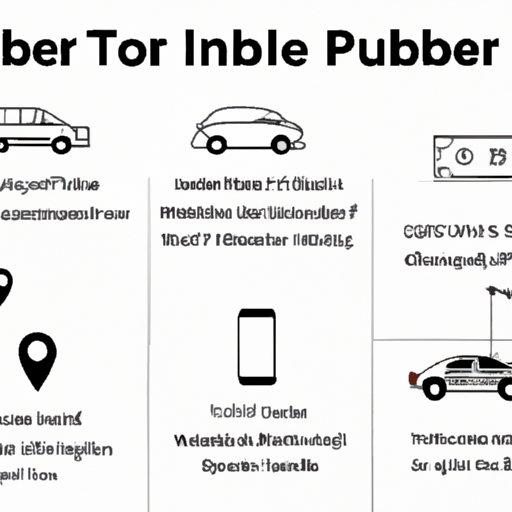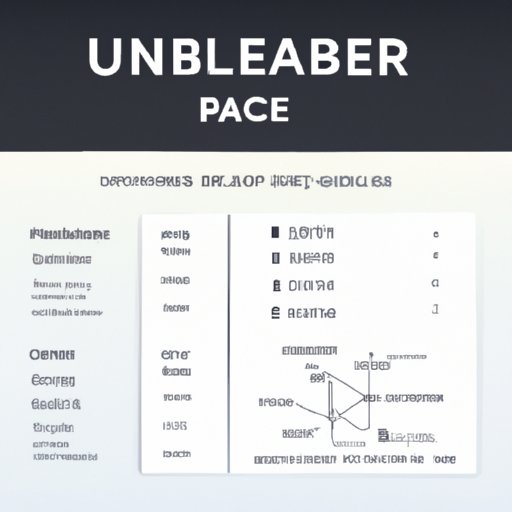Introduction
Uber is a ride-hailing platform that has changed the way people move around cities worldwide. With a few taps of the app, you can request a ride from anywhere, anytime. But one of the most important things to consider when using Uber is the pricing. So, how does Uber pricing work?
Exploring the Uber Pricing Model: How Does it Work?
Uber’s pricing system is based on time and distance traveled. The price of your ride is calculated by multiplying the base fare by the estimated time and distance of the trip. The base fare includes things like the booking fee, service fee, and safety fee. Additional fees may apply depending on the type of vehicle you choose and surge pricing.
Fares Based on Time and Distance
The cost of your Uber ride depends on a number of factors, such as the type of car you choose, the distance you travel, and the duration of the trip. The estimated fare for your ride is calculated by multiplying the base fare by the estimated time and distance of the trip. This means that longer trips and trips with more stops will cost more than shorter trips.
Surge Pricing
Surge pricing is an additional fee that is added to your fare during periods of high demand. During peak times, fares can increase significantly. Surge prices are designed to incentivize drivers to stay on the road and meet the demand for rides. When surge pricing is in effect, the app will let you know before you request a ride.
Base Fare vs. Additional Fees
The base fare includes things like the booking fee, service fee, and safety fee. In addition to the base fare, there may be additional fees added to your fare. These fees include things like the toll fee, airport fee, and parking fee. You can view a breakdown of all the fees associated with your ride in the app after your trip has been completed.

A Comprehensive Guide to Understanding Uber Pricing
If you’re new to Uber or just want to brush up on the basics of pricing, this comprehensive guide will help. We’ll cover topics like cost estimates, cancellation fees, and tips.
Cost Estimates
Before you request a ride, you can get an estimate of the total cost of your trip. The estimated fare is based on the estimated time and distance of the trip, as well as any additional fees that may apply. However, keep in mind that the actual cost of your trip may be higher or lower than the estimated fare, depending on traffic and other factors.
Cancellation Fees
If you cancel your ride after two minutes of requesting it, you will be charged a cancellation fee. The fee is based on the type of car you requested and the estimated fare of the trip. Keep in mind that if you cancel within two minutes of requesting the ride, you won’t be charged a cancellation fee.
Tips
Tipping your driver is optional, but if you choose to do so, you can do so through the app. You can add a tip to your fare at the end of your ride, or you can leave a cash tip directly with your driver. All tips are sent directly to the driver and are not included in the fare.
Demystifying Uber Fare Calculations: What You Need to Know
Uber’s fare calculation system can be confusing, so it’s important to understand how it works. There are a few different types of fare calculations, and each type takes different factors into account.
Factors Considered in Fare Calculations
When calculating your fare, Uber takes into account a variety of factors, including the type of car you choose, the distance you travel, the duration of the trip, and any additional fees that may apply. The estimated fare for your ride is calculated by multiplying the base fare by the estimated time and distance of the trip.
Different Types of Fare Calculations
There are a few different types of fare calculations used by Uber. The most common type is the time and distance-based fare, which calculates your fare based on the estimated time and distance of the trip. Other types of fare calculations include flat rate fares, minimum fares, and surge pricing.
Unpacking the Uber Price System: An In-Depth Analysis
If you’re looking to go beyond the basics of understanding Uber’s pricing system, this in-depth analysis will help. We’ll look at factors that impact prices, historical price increases, driver incentives, passenger subsidies, and the role of competition.
Factors that Impact Prices
There are a number of factors that can affect the price of your Uber ride. These include the type of car you choose, the distance you travel, the duration of the trip, and any additional fees that may apply. Additionally, surge pricing can also increase the cost of your ride.
Historical Price Increases
Uber has implemented several price increases over the years. These price increases were designed to offset rising costs, such as labor costs and fuel prices. Despite the price increases, Uber remains one of the most affordable ride-hailing services available.
Analyzing Uber Fare Structures: What’s Behind the Cost?
In order to better understand Uber’s fare structures, it’s important to look at the factors that influence prices. We’ll explore driver incentives, passenger subsidies, and the role of competition.
Driver Incentives
Uber offers incentives to drivers to encourage them to stay on the road and meet customer demand. These incentives can include bonuses for completing a certain number of trips, discounts on fuel, and more. Additionally, Uber also offers rewards programs for drivers to maximize their earnings.
Passenger Subsidies
Uber also offers subsidies to passengers to keep fares low. These subsidies can come in the form of discounts, promotional codes, and other special offers. By offering subsidies, Uber is able to keep fares competitive while still providing a reliable service.
The Role of Competition
Competition also plays an important role in Uber’s pricing structure. As more ride-hailing services enter the market, Uber has had to adjust its pricing in order to remain competitive. This has resulted in lower fares for passengers, as well as higher earnings for drivers.
Conclusion
Uber’s pricing system can be complicated, but understanding it is key to making informed decisions when using the service. This comprehensive guide has explored how Uber pricing works, demystifying fare calculations and analyzing what’s behind the cost. By taking the time to learn about Uber’s pricing model, you’ll be better equipped to make the most of your Uber experience.
Summary of Key Points
Uber’s pricing system is based on time and distance traveled. Additional fees may apply, such as surge pricing and additional fees like tolls and airport fees. Before requesting a ride, you can get an estimate of the total cost of your trip. You can also leave a tip for your driver through the app. Finally, there are a number of factors that influence Uber’s pricing, including driver incentives, passenger subsidies, and the role of competition.
Final Thoughts
By taking the time to understand how Uber’s pricing works, you’ll be better equipped to make informed decisions when using the service. Whether you’re a frequent Uber user or just trying out the service for the first time, this guide will help you navigate the complexities of Uber’s pricing system.
(Note: Is this article not meeting your expectations? Do you have knowledge or insights to share? Unlock new opportunities and expand your reach by joining our authors team. Click Registration to join us and share your expertise with our readers.)
